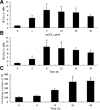Tenascin-C produced by oxidized LDL-stimulated macrophages increases foam cell formation through Toll-like receptor-4
- PMID: 22699754
- PMCID: PMC3887780
- DOI: 10.1007/s10059-012-0054-x
Tenascin-C produced by oxidized LDL-stimulated macrophages increases foam cell formation through Toll-like receptor-4
Abstract
Atherosclerosis is a chronic inflammatory disease in which both innate and adaptive immunity are involved. Although there have been major advances in the involvement of toll-like receptor 4 (TLR4) and CD36 in the initiation and development of this disease, detailed mechanisms remain unknown. Here, we show that tenascin-C (TN-C) can stimulate foam cell formation and this can be inhibited by a TLR4-blocking antibody or CD36 gene silencing. Our results identify TN-C-TLR4 activation as a common molecular mechanism in oxLDL-stimulated foam cell formation and atherosclerosis. In addition, CD36 is the major scavenger receptor responsible for the TN-C-mediated foam cell formation. Taken together, we have identified that TNC produced by oxLDL-stimulated macrophages increases foam cell formation through TLR4 and scavenger receptor CD36.
Figures






References
-
- Amin K., Lúdviksdóttir D., Janson C., Nettelbladt O., Gudbjórnsson B., Valtysdottir S., Björnsson E., Roomans G., Boman G., Seveus L. Inflammation and structural changes in the airways of patients with primary Sjögren’s syndrome. Respir. Med. 2001;95:904–910. - PubMed
-
- Andersson J., Libby P., Hansson G.K. Adaptive immunity and atherosclerosis. Clin. Immun. 2010;134:33–46. - PubMed
-
- Ashraf M.Z., Gupta N. Scavenger receptors: implications in atherothrombotic disorders. Int. J. Biochem. Cell Biol. 2011;43:697–700. - PubMed
-
- Chang Y.C., Huang K.X., Huang A.C., Ho Y.C., Wang C.J. Hibiscus anthocyanins-rich extract inhibited LDL oxidation and oxLDL-mediated macrophages apoptosis. Food Chem. Toxicol. 2006;44:1015–1023. - PubMed
-
- Chiquet-Ehrismann R., Chiquet M. Tenascins: regulation and putative functions during pathological stress. J. Pathol. 2003;200:488–499. - PubMed
MeSH terms
Substances
LinkOut - more resources
Full Text Sources
Miscellaneous

